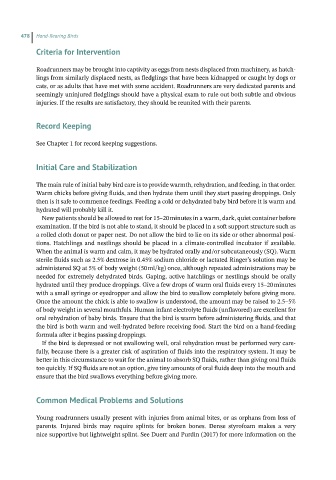Page 482 - Hand rearing birds second
P. 482
478 Hand-Rearing Birds
Criteriafor Intervention
Roadrunners may be brought into captivity as eggs from nests displaced from machinery, as hatch-
lings from similarly displaced nests, as fledglings that have been kidnapped or caught by dogs or
cats, or as adults that have met with some accident. Roadrunners are very dedicated parents and
seemingly uninjured fledglings should have a physical exam to rule out both subtle and obvious
injuries. If the results are satisfactory, they should be reunited with their parents.
Record Keeping
See Chapter 1 for record keeping suggestions.
InitialCareand Stabilization
The main rule of initial baby bird care is to provide warmth, rehydration, and feeding, in that order.
Warm chicks before giving fluids, and then hydrate them until they start passing droppings. Only
then is it safe to commence feedings. Feeding a cold or dehydrated baby bird before it is warm and
hydrated will probably kill it.
New patients should be allowed to rest for 15–20 minutes in a warm, dark, quiet container before
examination. If the bird is not able to stand, it should be placed in a soft support structure such as
a rolled cloth donut or paper nest. Do not allow the bird to lie on its side or other abnormal posi-
tions. Hatchlings and nestlings should be placed in a climate‐controlled incubator if available.
When the animal is warm and calm, it may be hydrated orally and/or subcutaneously (SQ). Warm
sterile fluids such as 2.5% dextrose in 0.45% sodium chloride or lactated Ringer’s solution may be
administered SQ at 5% of body weight (50 ml/kg) once, although repeated administrations may be
needed for extremely dehydrated birds. Gaping, active hatchlings or nestlings should be orally
hydrated until they produce droppings. Give a few drops of warm oral fluids every 15–20 minutes
with a small syringe or eyedropper and allow the bird to swallow completely before giving more.
Once the amount the chick is able to swallow is understood, the amount may be raised to 2.5–5%
of body weight in several mouthfuls. Human infant electrolyte fluids (unflavored) are excellent for
oral rehydration of baby birds. Ensure that the bird is warm before administering fluids, and that
the bird is both warm and well‐hydrated before receiving food. Start the bird on a hand‐feeding
formula after it begins passing droppings.
If the bird is depressed or not swallowing well, oral rehydration must be performed very care-
fully, because there is a greater risk of aspiration of fluids into the respiratory system. It may be
better in this circumstance to wait for the animal to absorb SQ fluids, rather than giving oral fluids
too quickly. If SQ fluids are not an option, give tiny amounts of oral fluids deep into the mouth and
ensure that the bird swallows everything before giving more.
CommonMedicalProblemsand Solutions
Young roadrunners usually present with injuries from animal bites, or as orphans from loss of
parents. Injured birds may require splints for broken bones. Dense styrofoam makes a very
nice supportive but lightweight splint. See Duerr and Purdin (2017) for more information on the

